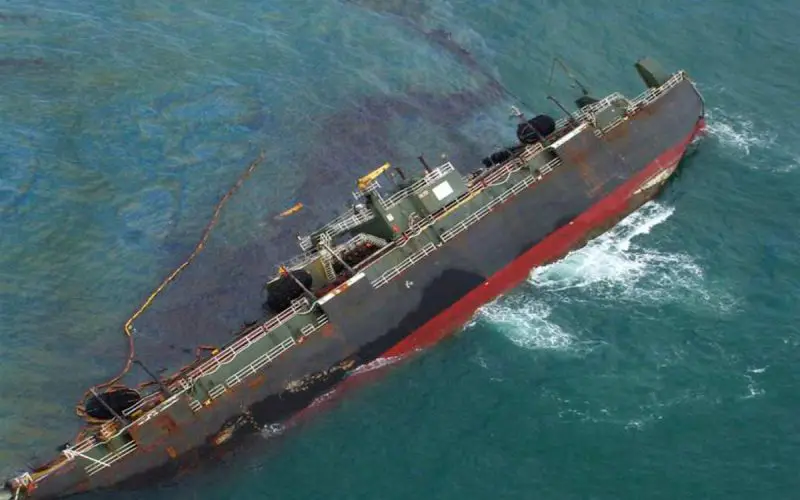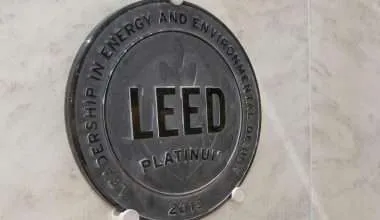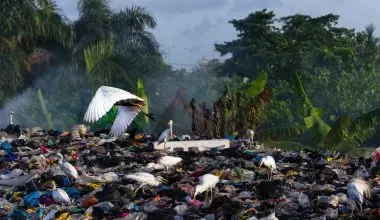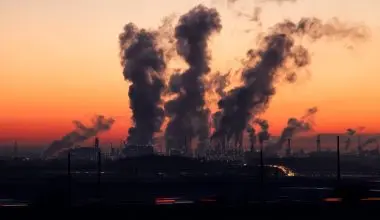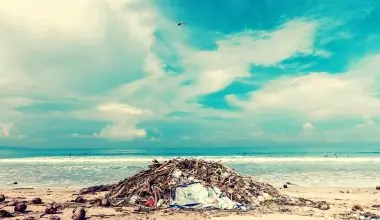Table of Contents Show
Just the other day, I was visiting a beach in a third-world country. While walking on the beach, I noticed the seawater turn green with green-colored froth making it’s way onto the shore. Just a few minutes passed and I noticed a dead fish washed up the shore. Alas, nothing could be done at that point to reverse those effects.
This made me realize how detrimental oil spills have become and how important it is for us to discuss and raise awareness about the Causes, Effects and Solutions to oil spills.
What are Oil Spills?
Oil spill is a type of pollution that can occur on land or on water, but mostly oil spills are found in oceans. Oil spill is basically the release or spillage of petroleum products (crude oil, gasoline, petroleum fuels and other by-products) and are mostly caused by human errors.
Some of the well-known oil spills are; 1989 Exxon Valdez Oil spill in Alaska and Deepwater Horizon Spill in the Gulf of Mexico in 2010. Deepwater horizon oil spill was by far the worst oil spill recorded in history. This resulted in spillage of 210 Million U.S. gallons (4.9 million barrels) of oil into the sea.
The latest major oil spill we’ve seen is the MV Wakashio spill that occurred South of Mauritius offshore of Pointe d’Esny. It happened as the Wakashio oil tanker hit a coral reef on the ocean bed on 25 July 2020. The ship began leaking fuel oil after the incident. Later on in August, the ship broke apart in half and released the remaining oil.
Pollution as a result of oil spillage, on land or water, is often referred to as oil pollution.
Causes of Oil spills
Oil spills have natural and anthropogenic (human-based) causes.
Natural causes
Oil is a fossil fuel which is formed by sedimentation of organic material of dead living organisms after many years. Therefore, underneath the land and sea, there are reservoirs of oil which can spill in case of natural disturbances like earthquakes, hurricanes, climate changes and so on.
For the oil trapped under the sea, there is another risk factor. On the ocean bed, the sedimentary rocks are directly in contact with moving water which can easily erode and expose the oil, causing spillage.
Sadly, due to thousands of miles of ocean floor being difficult to monitor, oil spills under the sea are frequently overlooked. The best chance we have is that someone spots an oil slick on sea surface or observes ocean surface changing color without cause.
1. Natural events
Drilling facilities are also an easy target for natural disasters.
The Taylor oil spill in the Gulf of Mexico caused by Hurricane Ivan has been leaking oil at the rate of 300-700 barrels a day since 2004. It has been estimated to contain reserves of around 100 years.
Despite cleanup operations continuing for several years and millions flowing in, it is still impossible to clear out all of the oil.
Anthropogenic causes
On the other hand, the human or anthropogenic causes are the biggest contributors to this deadly form of pollution. Starting from extraction to consumption, there is a risk of spill at every stage.
2. Human errors
Most of the oil drilling currently takes place in the sea. And because oil rigs are machines made by humans, there is always a certain chance of technical issues.
The smallest of mistakes can often lead to the most disastrous of effects. Watch the documentary made on the Deepwater Horizon spill, you’ll see what I mean.
Sometimes these accidents are caused by human negligence as well. However, the point remains that oil rigs have a great potential of accidental spill.
This is evident from some of the recent incidents like the 2010 BP Deepwater Horizon disaster in the Gulf of Mexico which spewed 4 million barrels of oil into the water and the 2005 Mumbai High North Platform fire incident in the Indian ocean.
3. Transportation incidents
The weakest link in the cycle of oil consumption seems to be transportation.
There have been many accidents and collisions among oil tankers leading to spillage of tremendous amounts of oil, ranging up to millions of gallons. The featured image at the top also shows you how oil spills from tankers.
Not just oil tanker, but the pipelines carrying oil also face similar risks of leak/spillage. However, we can say that a tanker has a higher risk due to harsh marine environment that can speed up corrosion.
In addition to causing environmental disasters, such accidents also pose danger to human and animal life.
4. Storage Issues
Oil and its by-products are carefully stored in underground or surface tanks, but these also carry some risks.
There have been hundreds of such accidents as of now with the majority being caused by fire spread or explosion. These explosions can be linked to various causes which include poor maintenance, equipment failure, static electricity, lightening, etc.
Besides these, there are other issues with storage as well. Slowly-forming cracks can also develop leaks over time. These cracks are expedited when a tanker has to face harshly corrosive marine environment.
The department of Labor, USA has developed a robust set of safety standards for oil storage within OSHA (Occupational Safety and Health Administration) which need to be followed diligently by companies storing large quantities of oil.
5. Accidents during Consumption
Now we come to the consumption part of the oil cycle.
You may have seen many viral videos of people leaving cars unattended on fuel booths at the station. That’s because, to everyone’s surprise, it’s quite common!
Oil is used as a fuel for many different machineries and the majority of these contain some faults or leaks. There could also be leaks while using machines or while cleaning them, like when oil tankers are cleaned for maintenance purposes.
Although it might seem very miniscule; on a larger scale, oil leakages have a significant risk to aquatic life after runoff from land or by directly being released into water.
6. Wars
Another important cause of oil spill is war.
Middle eastern countries account for some of the biggest oil producers in the industry. Oil to countries is like bees to honey. Hence, there are huge interests of other countries, with involved politics, in securing drilling contracts across the region.
Due to such competitions, this region is victim to many deadly wars and civil unrest which means oil spills can occur at any stage of the cycle intentionally or unintentionally.
One of the largest oil spill due to war was the Gulf War Oil Spill resulting from the Gulf war in 1991. Iraq began spilling large amounts of crude oil into the Persian gulf. It was an attempt to deter American marine forces from landing on Kuwait’s coast.
Most recently, there were attacks in 2019 on two oil tankers while transiting through the gulf of Oman.
Similarly, Nigeria, second largest oil producer in the world, has seen an increasing number of oil spills since its oil wells were captured by militants.
7. Off-shore Drilling
Offshore drilling is a non-preventable cause of oil spills. Every year, North American Offshore drilling operations release 880,000 gallons of crude oil into the sea.
Just recently in 2018, the Trump administration jumped the gun to approve plans of expanding offshore drilling Atlantic, Pacific, Antarctic Oceans as well as the Gulf of Mexico. This proposal opens 90% of the pristine Outer Continental Shelf to new offshore drilling operations. This proposal has also been estimated to increase major oil spills frequency by 10 times.
Just imagine the rise in oil pollution as a result of these decisions. Meanwhile, Oil companies are enjoying this proposal since it opens up new avenues for them.
Effects of Oil spills
Since the industrial revolution, oil spills have been happening due to the above reasons. However, the large-scale problems that follow these spills and their effects have just begun to appear. Oil spills can take anywhere from a few days to decades in recovery.
1. Damage to Aquatic Life
The biggest victims of these spills are the marine animals that live in the water or near shores. Marine Oil spill is incredibly harmful to the poor species that come into direct contact with spilled oil.
Scientists have researched into the after-effects and recovery of species following the Exxon Valdez oil spill. The following graph will show you the recovery timelines of different species in the Gulf of Mexico.
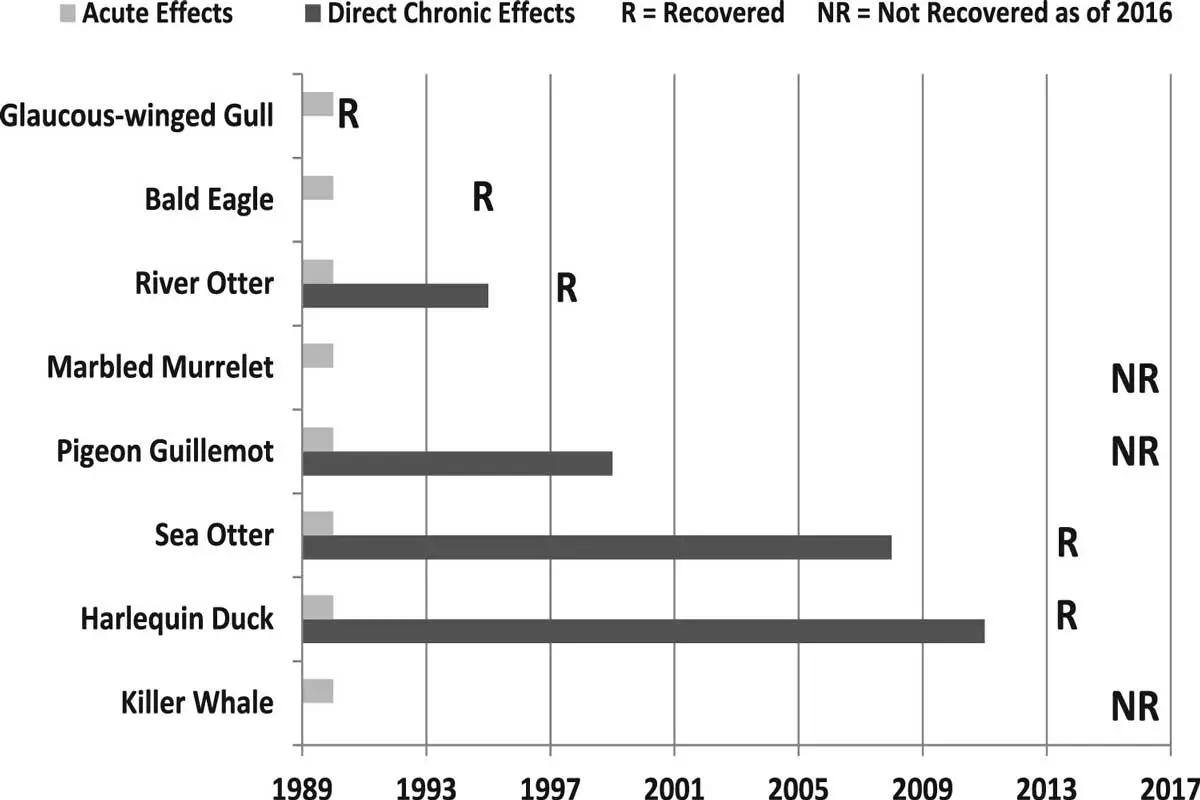
As you may have noticed, All of the aquatic species recorded in the Gulf of Mexico suffered acute effects after the Exxon Valdez Oil spill in 1989. Only a few of them recovered to pre-spill numbers after heavy efforts.
At least 4 of those species, have not recovered even after 25 years! There could be many more that didn’t recover since we monitored only a handful number of species. Some of them could even be keystone species.
2. Decreased Photosynthesis
When oil covers the surface of water it reduces the amount of light available to aquatic plants. This would mean reduced rates of photosynthesis.
This eventually results in the death of plants on the ocean bed. Without plants, the oxygen levels also start dropping. This leads to suffocation of most aquatic animals which depend on dissolved oxygen.
Learn more on How Plants Make Oxygen.
Essentially, the food cycle that begins with plants and followed by herbivores and carnivores is adversely affected, leading to potentially disastrous consequences.
This is scarily similar to cultural eutrophication which occurs in rivers alongside agricultural lands.
3. Easy Targets for Predators
Oil can stick to the fur on birds and animals. This reduces the insulating properties of fur, resulting in hypothermia. Hypothermia is where the body temperatures are significantly reduced, resulting in loss of internal body functions.
More specifically For birds, oil slicks on their fur also decreases their ability to fly. This makes them an easy prey for predators.
There are some birds who try to eat the oil on their bodies to be able to fly, but ingestion makes things worse.
4. Ingestion
Oil also causes extensive damage when ingested/consumed by these animals. The consequences of these have been faced by dolphins, sea otters, sea turtles and countless species of birds amongst others.
Tell me something, how bad would you feel if you were tricked into drinking oil rather than water? That’s how the innocent animals feel.
This is because oil is toxic for living things and can cause damage to various organs like the kidney, liver, eyes and lungs.
When a certain animal, which has consumed oil, is eaten by other predators; the toxic effects of oil are multiplied up the food chain. This makes it very detrimental to the whole aquatic life in the region.
Some of these fishes are also eaten by humans. This means we are also at the risk of consuming oil through fish.
5. Economic Losses
Going forward, the effects are not just limited to the health issues but lead to economic losses as well.
With oil spills, the oil industry suffers quite a loss. It’s not just the loss of commodities but also the increasing burden of cleaning up and conducting rescue operations.
For the workers, it can also mean unemployment if the losses exceed a sustainable limit.
6. Losses to fishing industry
The fishing industry can also feel similar ripples. This is because oil spills make it difficult to catch fish.
Even when caught, the demand starts decreasing as people try to avoid seafood due to the risks of getting oil in their systems.
Toxic chemicals have a way of increasing in concentration as you go up the food chain. Marine mammals like whales are usually at the top of the food chain. When humans consume these marine animals, they are actually consuming high levels of hydrocarbon as a result of oil spills.
7. Losses to tourism industry
Similarly, the tourism industry also suffers a huge setback with dead animals and birds piling up on the shores. All water activities like rafting, swimming, sailing may also be suspended. This can heavily impact the tourism industry at-present and for years to come.
This is yet another economic loss which the country’s economy suffers from.
With all these effects obvious as of now, still many companies lack proper plans or guidelines to handling such unfortunate events or accidents.
The Mauritius oil spill this year was detrimental to the tourism industry of Mauritius. Mauritius economy is highly dependent on tourism industry which accounts for 63 billion Mauritian rupees ($1.69 Billion dollars). Tourists are attracted to scenic beaches and marine life which is likely to be endangered as a result of this spill.
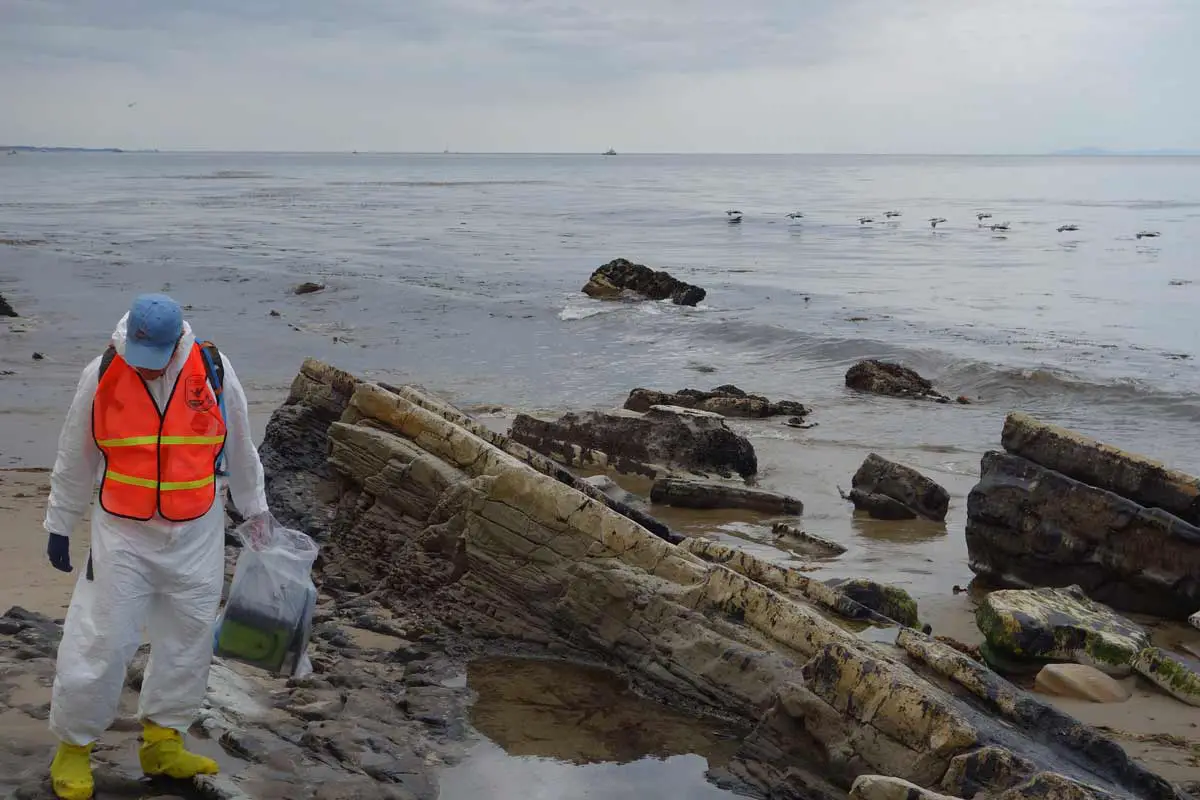
P.S: Sand sampling is also done at the nearest beach.
Solutions to Oil Spills
Oil spills endanger public health, impact drinking water, devastate natural resources, and disrupt the economy. We use vast quantities of oils to heat our homes, provide fuel for automobiles, and operate various pieces of equipment.
During storage, transport, or as the result of energy exploration and production activities; oil and other oil-based products are sometimes spilled onto land or into waterways. When this occurs, human health and environmental quality are put at risk.
One liter of oil spill contaminates a million liters of water.
Every effort must be made to prevent oil spills and to clean them up promptly once they occur. The costs associated with spill prevention are often much less than the costs associated with spill cleanup, fines, and other civil liabilities.
As the old adage states;
“an ounce of prevention is worth a pound of cure.”
The purpose of the Spill Prevention, Control, and Countermeasure (SPCC) rule is to help facilities prevent a discharge of oil into navigable waters or adjoining shorelines. This rule is part of the U.S. Environmental Protection Agency’s oil spill prevention program and was published using the authority given by Clean Water Act of 1973.
Once the oil spill occurs, the environmental disaster resulting from the event can be difficult to control. However, various solutions have been devised to prevent Oil Spills and containing them after occurrence.
The top priorities include prevention, preparation for, and response to oil spills. These include those that occur in and around the world in open oceans, inland waters as well as coastal waters around the world.
Preventive Solutions to Oil Spills
- Storage tanks should be designed for storing flammable liquids like gasoline.
- Safeguards, such as alarms, must be installed to indicate overfilling of oil or accumulation of gas in storage tanks.
- A dike or embankment should be in place at a ground-based oil storage facility to function as a secondary containment. The area should be large enough to contain any future leakage of oil as well as expected rainfall.
- Depending on the type of container, integrity testing should be carried out on periodical basis. It may involve external visual inspection or more complicated methods of non-destructive testing like Magnetic Flux Leakage (MFL) or ultrasonic thickness (UT) measurements, vacuum box testing, and weld inspection by trained personnel in order to adequately assess the container condition.
- Industry standards for oil storage such as those applied by Spill Prevention, Control and Countermeasure (SPCC) rules should always be in place.
- For ship-sourced oil spill, risk assessment has to be carried out for determining the most likely location of potential ship-source oil spills, the likelihood of different sizes of spills occurring, and the potential impacts and consequences of spills.
Risk assessments can provide the basis upon which appropriate prevention, mitigation, and preparedness measures can be planned.
Conducting risk assessments and defining risk tolerance levels are also useful for informing decisions on the amounts of resources needed for responding to a spill (also known as spill response equipment) and where these resources should be located.
Risk assessments also provide an opportunity for engaging local communities and informing them of the risks present in their environment resulting from oil shipments.
Containment Solutions for Oil Spills
Ship-source oil spills will likely continue to occur and affect local environments and economies.
Emergency plans are important for decision-making authorities in directing response efforts, outlining response procedures, and identifying the needs of equipment, training and exercises. This is because there is no time to spare when executing an oil spill response.
Up-to-date plans facilitate coordinated responses aimed at mitigating and minimizing the impact of oil spills.
The methods commonly used to contain oil spills are as following;
1. Oil Booms
These are simple and a popular way to limit the spread of oil on surface. Equipment called containment booms acts like a fence to prevent the oil from further spreading or floating away.
These float on water and consist of
- A freeboard floating above the water surface that prevents oil from going to the other side.
- A skirt below the surface prevents oil from escaping from below the boom.
- A cable to connect the booms to form a containment perimeter.
This method is effective when the oil spill is in its early stages and concentrated in one area. The Booms are not effective in rough seas.
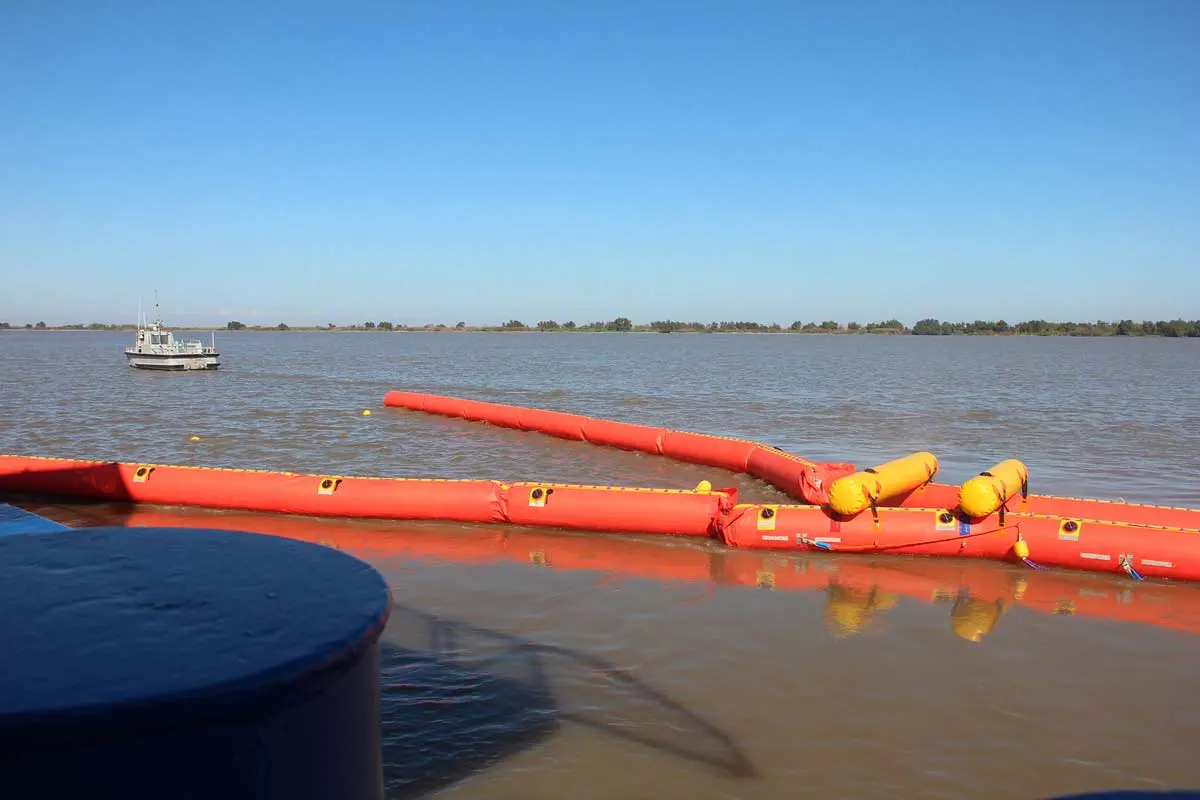
2. Skimmers
Skimmers or oil scoops can be deployed through boats to remove the contaminants from the water surface.
This is usually done after the spread of oil has been contained into a concentrated area by oil booms.
Skimmers are machines specially designed to suck up the oil from the water surface like a vacuum cleaner. They are used to physically separate the oil from the water. This is so that it can be collected and processed for re-use.
3. Sorbents
Sorbents are materials that absorb fluids by either absorption (getting in through pores) or adsorption (forming a layer on the surface). Both of these properties make the process of clean-up much easier.
Materials commonly used as oil sorbents are hay, peat moss, straw or vermiculite.
The best part about this this method is that oil can be recovered. This prevents wastage and further pollution, but the sorbent chemicals must be recovered after the absorption which is a difficult task. The presence of sorbents poses a risk to aquatic life, if left behind in the ocean.
This technique is useful to clean up small spills and leftover traces of larger spills.
4. Burning
The oil floating on the surface can be ignited to burn it off. This in-situ burning of oil can effectively remove up to 98% of an oil spill, which is more than most of the other methods.
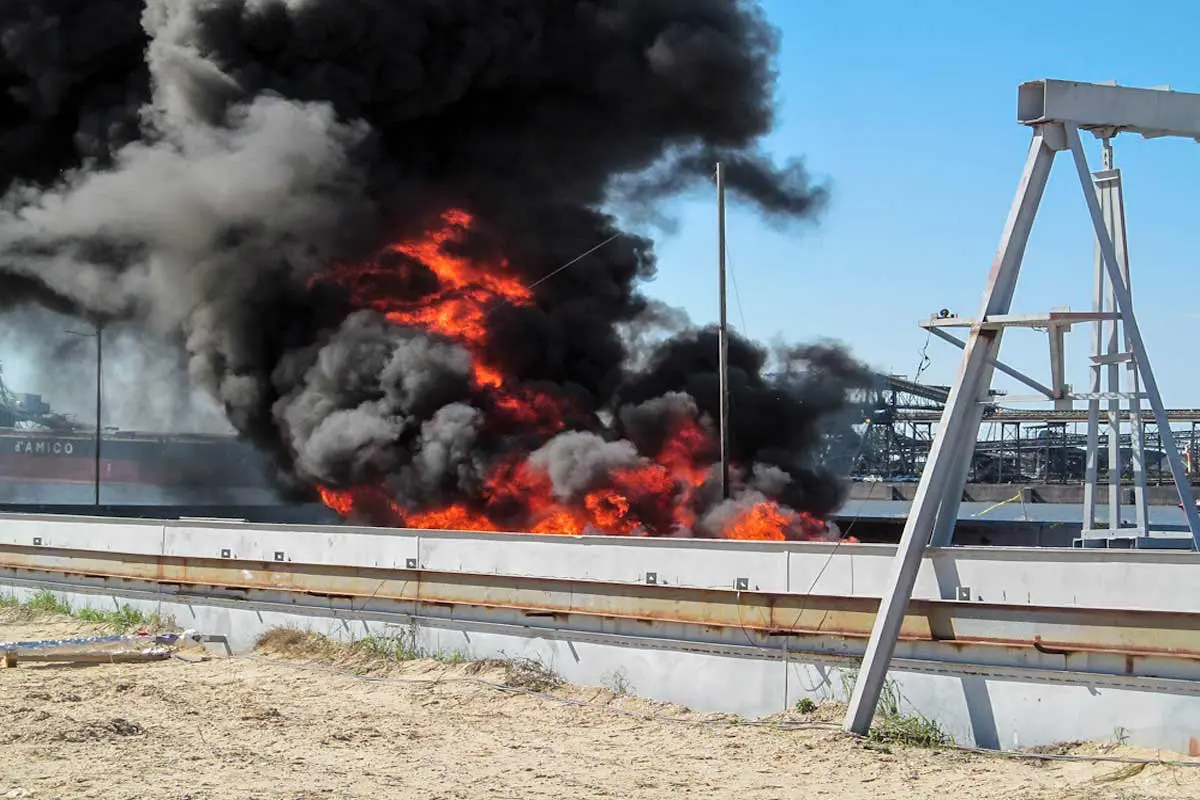
In order for in-situ burning to be effective, the oil layer has to be at least 3mm thick.
The major disadvantage of this method is that toxic fumes released from the burning can cause significant damage to the environment as well as marine life.
Additionally, burning in-situ is only effective for relatively fresh oil spills before it spreads over a large area.
5. Applying Dispersants
When the spilled oil cannot be contained using booms and a large area has to be covered, another option left is to accelerate the disintegration of oil by applying Dispersal agents.
These are chemicals sprayed upon the spill with the help of aircraft and boats. They aid in the natural breakdown of oil components. This is will allow quick dispersal of oil so that the direct effects of oil (suffered by the marine life and birds) are minimized.
They allow the oil to chemically bond with water by increasing the surface area of each molecule. This ensures that the slick does not travel over the surface of the water, and is easier to degrade by microbes.
This method is damaging to the environment because the toxicity of chemical dispersant affects aquatic life such as corals and sea grass. However, it’s use is warranted when the benefits outweigh the risks or if this is the only option available.
Another disadvantage is that the dispersants can form Tarballs. Tarballs are a mixture of oil, water, sand and debris present in the water. These can wash up to shores as well. This will significantly affect the tourism industry if it thrives on beaches, like in Maldives.
6. Hot Water and High-Pressure Washing
In areas where leaked oil is inaccessible for other techniques of oil removal such as booms and skimmers; high pressure hot water jets are used to dislodge oil sludge from sea bottom.
This pushes oil sludge up towards the surface for collection with skimmers or sorbents.
After the Exxon Valdez Oil spill in 1989, scientists have discovered pressure washing to be causing more harm than good.
7. Using Manual labor to Clean Contaminated Shores
For cleaning up oil slicks on the shore line, manual labor is used to clean up the contaminants by hands, rakes and shovels etc.
Their goal is to clean the oil and debris piling up on shore and placing these in special containers for further disposal.
This method is not expensive as it requires unskilled labor but it is very time consuming. Mechanical shovels are sometimes used to excavate the contaminated soil.
8. Bioremediation
Specific microorganisms are used for removal of toxic or dangerous substances in bioremediation. Some classes of bacteria, fungi or algae break up complex hydrocarbons of petroleum products into simpler non-toxic molecules. These bacteria die and decompose after eating up and breaking down oil spills.
Again, as any biological process, Bioremediation takes time. It can be used as an adjunct with other oil spill control methods, but not solely.
9. Chemical Stabilization of Oil by Polymeric Agents
As soon as oil spill occurs, the immediate response is to prevent it from spreading.
Although physical methods such as oil booms are an effective measure to contain the oil spill, but keeping in view the seriousness of the ecological consequences additional measures need to be taken
The use of chemical compound like ‘Elastol’ has recently been used to good effect to confine oil spills. Elastol is basically poly iso-butylene (PIB) in a white powdered form. It makes a gel-like substance as it comes in contact with oil.
The non-toxic polymeric agent gelatinizes or solidifies the oil on the water surface and thus keeps it from spreading or escaping. The gelatin is easy to retrieve, and this makes the process highly efficient.
Moreover, it is quick to act with a reaction time of 15 to 40 minutes.
10. Role of NOAA after an Oil spill
NOAA experts are to oil spills like doctors to their patients. NOAA experts’ main role is after an oil spill occurs. They evaluate what happened, assess the impacts of the spilled oil and then they design and decide appropriate interventions to help in restoration.
Restoration is more advanced than a simple oil spill cleanup. It involves multiple separate projects like building marshlands or protecting the bird nesting habitats. These projects will actively promote regeneration of the environment.
Restoration projects are necessary because they speed up the regeneration process of species and their habitats.
Having discussed various solutions to oil spills there is a need to realize that any oil spill constitutes an ecological disaster of the first order. Prevention takes priority over all other measures to mitigate the effects of oil through extraction and removal of contaminants.
P.S: This is another reason to start increasing awareness regarding biofuels. Biofuel spills are relatively safe since they can be degraded by bacteria. Here are the articles we’ve written on biofuels:
- How Biofuels Work and How to Make Biofuels!
- Biodiesel; Definition, Advantages and Disadvantages
- Pros and Cons of Biofuels
- Biomass Fuel Types and Examples
If you’re interested in another topic, just perform a quick search and let’s get together in our fight to saving the environment!
